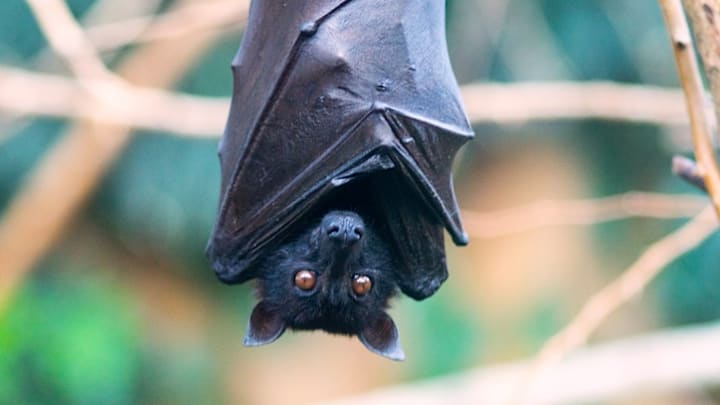In China, bats are said to bring good luck. Ancient Egyptians believed they could cure an array of diseases. But Westerners’ feelings about bats are often negative. Perhaps these rumors started because bats are so mysterious—with their nocturnal flying and dank, dark habitats, they’re hard to study. But the only flying mammals in the animal kingdom aren’t nearly as scary as our fears make them out to be. Keep reading for seven misconceptions and explanations of what really goes on in the batcave.
- Myth: Bats are totally blind.
- Myth: Bats are just flying rats.
- Myth: Bats are annoying pests.
- Myth: Bats want to drink your blood.
- Myth: Bats will fly into your hair and build nests.
- Myth: Bats always hang upside down.
- Myth: Bats will attack you and give you rabies.
Myth: Bats are totally blind.

That old idiom is definitely inaccurate. Bigger bats can see up to three times better than humans, Rob Mies, former executive director of the Organization for Bat Conservation, told National Geographic. Bat vision varies across species, but none is actually blind. In addition to working peepers, bats also use echolocation (emitting sound to navigate)—which means they probably have a better idea of where they’re going than many of us.
Myth: Bats are just flying rats.

Bats belong to the order Chiroptera—not Rodentia. They’re actually more closely related to primates than they are to rodents. They also don’t share behavior with rodents. For example, bats don't chew on wood, metal, or plastic, and usually aren't considered “nuisance” animals.
You May Also Like:
- A Bright Side for Bats: Scientists Make Progress Against White Nose Syndrome
- Why 7 Animals Became Associated With Halloween
- Can You Spot the Hidden Bat in This Spooky Image?
Add Mental Floss as a preferred news source!
Myth: Bats are annoying pests.

Quite the opposite: Bats actually eat pests. Some species can eat up to a thousand insects in an evening. Their bug-eating prowess is so notable it carries economic importance. A 2011 study calculated that bats provide nontoxic pest-control services for agriculture worth $3.7 billion to $53 billion per year. Bats also pollinate plants and distribute seeds, and their droppings, called guano, are used as fertilizer.
Myth: Bats want to drink your blood.

Only three of the roughly 1200 existing bat species are vampire bats, and none of them lives in the United States or Canada. Vampire bats don't even really drink blood—Mies said the feeding process is more like that of a mosquito. While mosquitos will take blood from humans, though, vampire bats primarily feed on cattle. Fun fact: a protein in vampire bat saliva, which keeps blood from clotting as the bat feeds, is called draculin.
Myth: Bats will fly into your hair and build nests.

An old myth claims that bats fly into hair, get stuck, and build nests. While it’s possible this rumor started to deter young women from going out at night, bats do sometimes swoop around people’s heads. The reason isn’t because they’re shopping for a new home, however: Our bodies attract insects, and bats are after their next snack. So don't worry—your spectacular updo is safe. In fact, bats don’t build nests at all. They find shelter inside existing structures. Caves, trees, walls, and ceilings are favorites, as are rafters of buildings
Myth: Bats always hang upside down.

Contrary to the popular image, bats don’t always dangle downwards. Bats are frequently horizontal, not vertical, when they roost in small crevices.
Myth: Bats will attack you and give you rabies.

Nope. Shari Blissett Clark, president of the Florida Bat Conservancy, told the Daytona Beach News-Journal that bats contract rabies much less frequently than other mammals. And if they do get rabies, it manifests differently than in raccoons or foxes. Rabies-infected bats become paralyzed and can't fly or roost. This means that as long as you stay away from bats on the ground that are behaving strangely, you're pretty much in the clear.
A version of this story was published in 2019; it has been updated for 2025.
